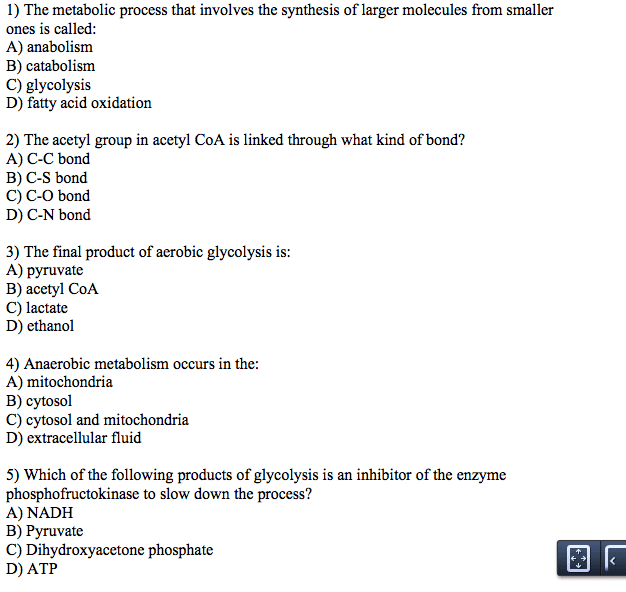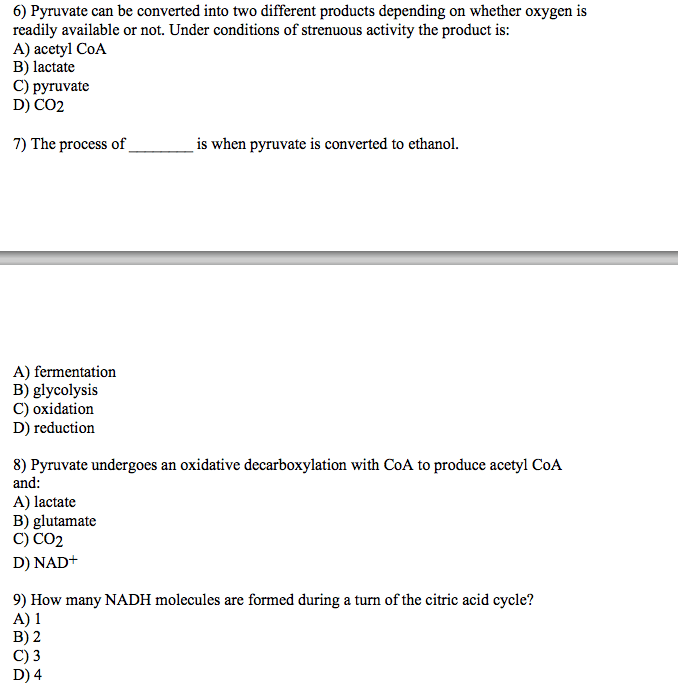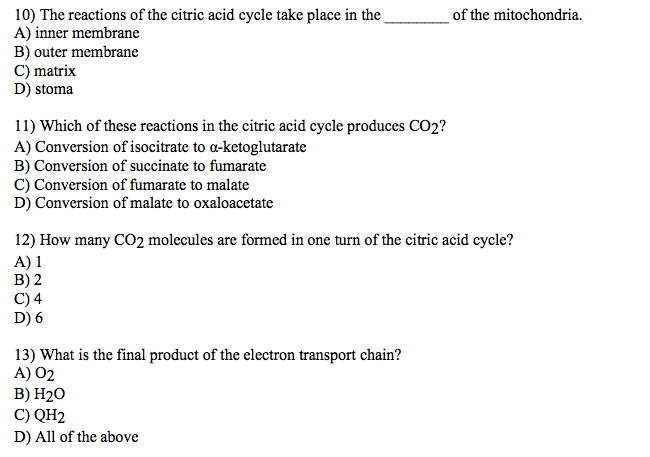1. Plants need which of the following to carry on photosynthesis?
a. H2O
b. CO2
c. O2
d. both O2 and CO2
e. both H2O and CO2
2. Organisms that derive their chemical energy either from the process of chemosynthesis or photosynthesis are classified as
a. autotrophs.
b. parasites.
c. heterotrophs.
d. saprophytes.
e. mutualists.
3. The carbon source for organisms that derive their energy from photosynthesis is
a. carbon monoxide.
b. carbon dioxide.
c. hydrocarbons.
d. methane.
e. glucose.
4. The oxygen released in photosynthesis comes from
a. carbon dioxide.
b. glucose.
c. ribulose bisphosphate.
d. water.
5. When chlorophyll a molecules absorb energy, the molecules
a. release electrons.
b. release X-rays.
c. release energy.
d. release electrons and X-rays.
e. release electrons and energy.
6. The flow of what particle across the thylakoid membrane powers the production of ATP?
a. electrons
b. hydrogen ions
c. oxygen
d. carbon dioxide
e. phosphate ions 2
7. The light-independent reactions were discovered by
a. M. D. Hatch.
b. Andrew Benson.
c. Melvin Calvin.
d. Robert Hill.
e. both Andrew Benson and Melvin Calvin.
8. For each six atoms of carbon dioxide fixed in the light-independent reactions, how many molecules of PGAL (phosphoglyceraldehyde) are produced?
a. 2
b. 3
c. 6
d. 12
e. 15
Chapter 7
9. The ultimate source of energy for living things is
a. the Krebs cycle.
b. fossil fuels.
c. the sun.
d. glycolysis.
e. aerobic respiration.
10. When molecules are broken apart in respiration
a. the heat produced is used to drive biological reactions.
b. the oxygen in the compounds that are broken apart is used as an energy source.
c. the energy released in respiration is channeled into molecules of ATP.
d. ATP is converted into ADP.
e. ADP is released as a waste product.
11. ATP
a. can be produced by photosynthesis.
b. is produced in the degradation of organic compounds such as glucose.
c. is generated in anaerobic respiration.
d. is released in aerobic respiration.
e. all of these
12. Which part of the energy-releasing pathway can convert all carbon that enters to carbon dioxide?
a. fermentation
b. glycolysis
c. Krebs cycle
d. electron transport
e. phosphorylation
13. Which liberates the most energy in the form of ATP?
a. aerobic respiration
b. anaerobic respiration
c. alcoholic fermentation
d. lactate fermentation
e. All liberate the same amount, but through different means.
14. Aerobes use ________ as the final electron acceptor in electron transport phosphorylation.
a. hydrogen
b. carbon
c. oxygen
d. H2O 3
15. Glycolysis depends on a continuous supply of
a. NADP.
b. pyruvate.
c. NAD+.
d. NADH.
e. H2O.
16. Glycolysis
a. occurs in the mitochondria.
b. results in the production of pyruvate.
c. occurs in the cytoplasm.
d. occurs in the mitochondria and results in the production of pyruvate.
e. results in the production of pyruvate and occurs in the cytoplasm.
17. The end product(s) of glycolysis is(are)
a. acetyl CoA.
b. carbon dioxide.
c. pyruvate.
d. glucose.
e. glucose and carbon dioxide.
18. Which is capable of being reduced during both glycolysis and the Krebs cycle?
a. NAD+
b. FAD+
c. ADP
d. NADH
e. NADP+
19. The Krebs cycle takes place in the
a. ribosomes.
b. cytoplasm.
c. nucleus.
d. mitochondria.
e. chloroplasts.
20. The breakdown of pyruvate in the Krebs cycle results in the release of
a. energy.
b. carbon dioxide.
c. oxygen.
d. energy and oxygen.
e. energy and carbon dioxide.





